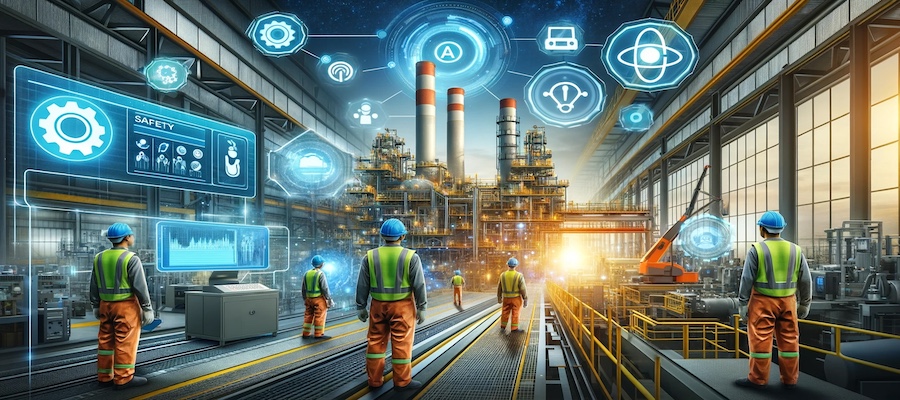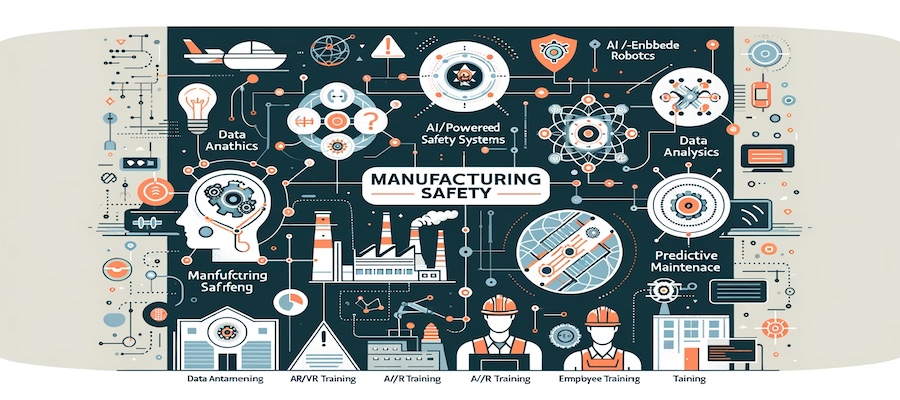AI-Driven Worker Safety in Manufacturing: Insights from Securade.ai's Video Analytics

The Evolution of Workplace Safety in Manufacturing
For years, the manufacturing sector has grappled with the dual challenge of ensuring worker safety and maintaining operational efficiency. Traditionally, this has involved a delicate balance of adhering to safety regulations, investing in protective equipment, and implementing rigorous training programs. However, the advent of Industry 4.0 has introduced a transformative solution: Artificial Intelligence (AI). According to the 2023 BDO Manufacturing CFO Outlook Survey, an impressive 36% of manufacturers are now looking towards AI investments to address long-standing safety challenges.
AI in manufacturing isn't just about automation; it's about creating a safer working environment. The most exciting development in this realm is Generative AI, like OpenAI's ChatGPT, which has shown immense potential in solving complex problems with its ability to process and analyze vast amounts of data. In the context of manufacturing, AI systems are being tailored to address specific safety challenges. These systems leverage inputs from computer vision, lasers, and other sensors not only to predict potential safety issues but also to provide actionable insights for preventing accidents and optimizing safety protocols.
The enthusiasm for AI in manufacturing is palpable. Plant managers are increasingly passionate about AI systems that can operate within the unique constraints of a manufacturing environment. Unlike the general-purpose AI applications that have captured the public's imagination, these specialized AI systems are designed to integrate seamlessly into the manufacturing workflow, enhancing safety without disrupting productivity.
AI-Powered Safety Systems: Predicting Hazards and Ensuring Compliance
In the realm of manufacturing, where safety is paramount, AI-powered systems have emerged as a game-changer. These systems are capable of predicting potential hazards and ensuring compliance with safety protocols, especially in critical areas such as the use of Personal Protective Equipment (PPE). For instance, Securade.ai leverages AI to monitor and enforce PPE compliance, addressing a significant challenge in the industry. Studies have shown that non-compliance with PPE protocols is a major cause of workplace injuries, sometimes leading to fatal accidents. According to the National Safety Council, manufacturing accounted for a significant portion of nonfatal injuries in recent years, highlighting the urgent need for more stringent safety measures.
AI's role in this context is transformative. By integrating with existing camera systems, AI solutions like those offered by Securade.ai can detect when employees are not wearing the necessary protective gear. This level of surveillance not only helps in reducing the risk of injuries but also ensures that the manufacturing units stay compliant with regulatory standards, thus avoiding costly penalties. The AI algorithms are designed to 'learn' and evolve, which means they continually improve in recognizing compliance issues, thereby reducing false positives and enhancing overall safety effectiveness.
Revolutionizing Safety Training with AR and VR Technologies
In the quest to enhance manufacturing safety, AR (Augmented Reality) and VR (Virtual Reality) technologies have taken center stage in revolutionizing safety training programs. These immersive technologies enable a more effective and engaging learning experience for employees, especially those who interact with AI-powered safety systems. For instance, AR or VR simulations can simulate working with potentially dangerous machinery, allowing workers to practice safety procedures in a risk-free environment before handling real equipment. This approach is crucial in reducing errors that could lead to workplace injuries.
Moreover, AR and VR training goes beyond traditional methods by familiarizing employees with AI systems designed to improve safety. Many workers have never interacted with AI systems actively enforcing safety guidelines and may initially be skeptical or resistant. However, through realistic simulations that include scenarios like machine breakdowns or safety protocol breaches, employees can learn about the hazards that AI safety systems can detect and how to respond appropriately.
One significant application of AI in safety training is through computer vision technology. AI can "see" the factory floor through cameras and raise safety alerts in real time if it detects any non-compliance, such as employees not wearing appropriate PPE. In geofenced safety zones, a computer vision-enabled AI can shut down equipment, restrict access to certain areas, and alert employees if it detects or anticipates a safety concern.

Enhancing Individual Worker Safety Through Data Analytics
AI's application in manufacturing safety extends to personalizing worker safety measures. Utilizing data analytics, AI systems can monitor and analyze individual safety incidents, such as warnings or violations. This analysis includes considering various factors like years of experience, hours worked, and physical strain metrics, possibly collected from wearable devices. Such comprehensive data allows manufacturers to construct a holistic view of each worker's safety record, identifying those who might benefit from additional training or are under excessive strain.
By understanding individual workers' safety profiles, manufacturers can better allocate tasks, matching employees with jobs that align with their skills and physical capabilities. This targeted approach not only enhances overall safety but also contributes to a more efficient and harmonious work environment. Data analytics powered by AI, therefore, plays a crucial role in sustaining a safe and productive manufacturing setting.
AI-Enabled Robotics and Drones for Safer Work Environments
AI-driven robotics and drones are increasingly pivotal in enhancing safety within manufacturing environments. These technologies are adept at taking over tasks with high injury risk, thereby keeping human workers away from hazardous conditions. For example, drones equipped with AI can perform inspections in challenging environments like high-ceiling warehouses, assessing the stability of stacked inventory or inspecting areas with hazardous chemicals, which significantly limits human exposure to potential dangers.
Robotic solutions, enabled by AI, are transforming workplaces by automating dangerous tasks, thus allowing human workers to focus on roles that require specific skills and dexterity. This shift not only enhances safety but also contributes to overall operational efficiency.
Embracing the New Efficiency Paradigm with AI in Manufacturing
AI's impact in manufacturing extends beyond safety to encompass efficiency, particularly through predictive maintenance. Traditional maintenance schedules, though preventive, can sometimes be inefficient, not being informed by actual repair needs. AI flips this paradigm, allowing for maintenance that is precise and timely. By analyzing data from various sensors, AI systems can predict equipment failures, scheduling repairs when least disruptive to operations.
AI also supports quality control by continuously scanning for errors, thus ensuring the optimal functioning of machines and maintaining product quality. This capability is particularly valuable in fast-paced production lines where manual monitoring can be challenging.
Overcoming Challenges: The Importance of Employee Buy-In
The successful integration of AI in manufacturing isn't just about technological implementation; it crucially hinges on employee acceptance and training. Workers need to be educated on how to interact with these new systems effectively. Addressing skepticism and demonstrating the practical benefits of AI through pilot projects are essential strategies. This approach reassures employees that AI is a tool for enhancing safety and efficiency, not a replacement for their roles. By fostering an environment of transparency and open dialogue, manufacturers can build trust in AI systems and ensure their successful adoption in the workplace.
Realizing the Full Potential of AI in Manufacturing Safety
AI in manufacturing stands at the forefront of a safety and efficiency revolution. However, its true potential is realized only when paired with well-planned strategies, including comprehensive employee training and robust infrastructure development. Manufacturers must recognize that investments in AI, from technology to training, are essential to achieving tangible improvements in worker safety and realizing cost savings from efficiency gains. The future of manufacturing safety, underpinned by AI, promises not only a safer working environment but also operational excellence.